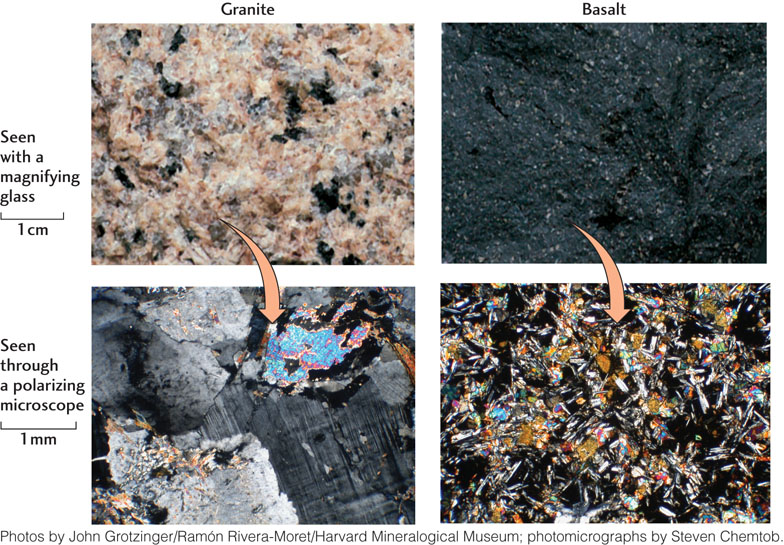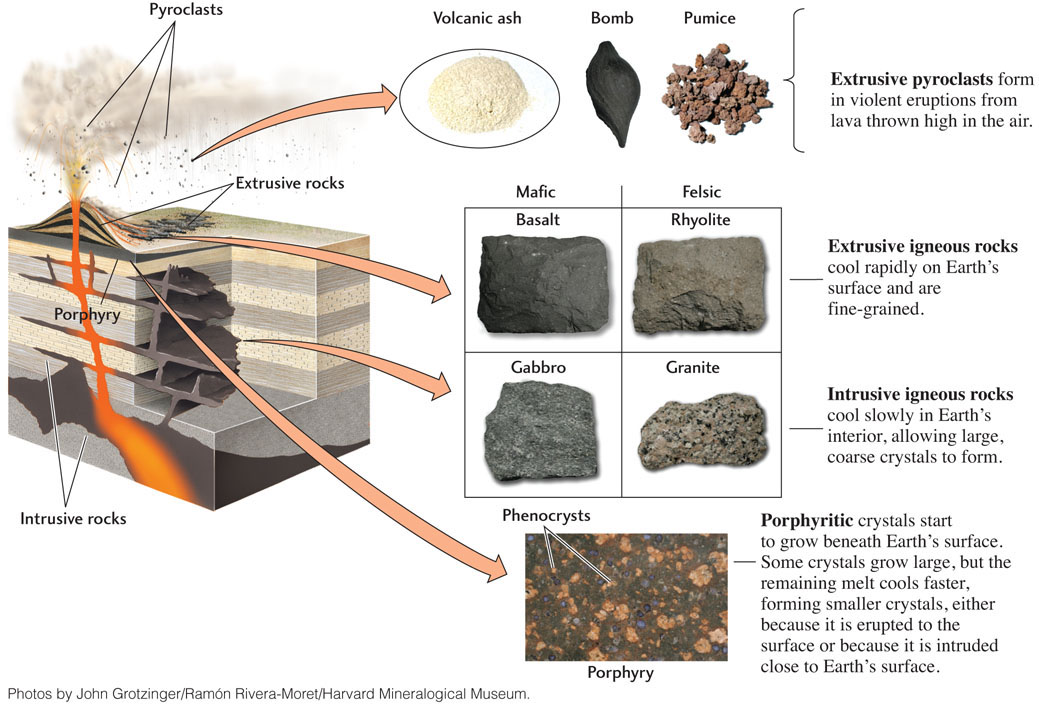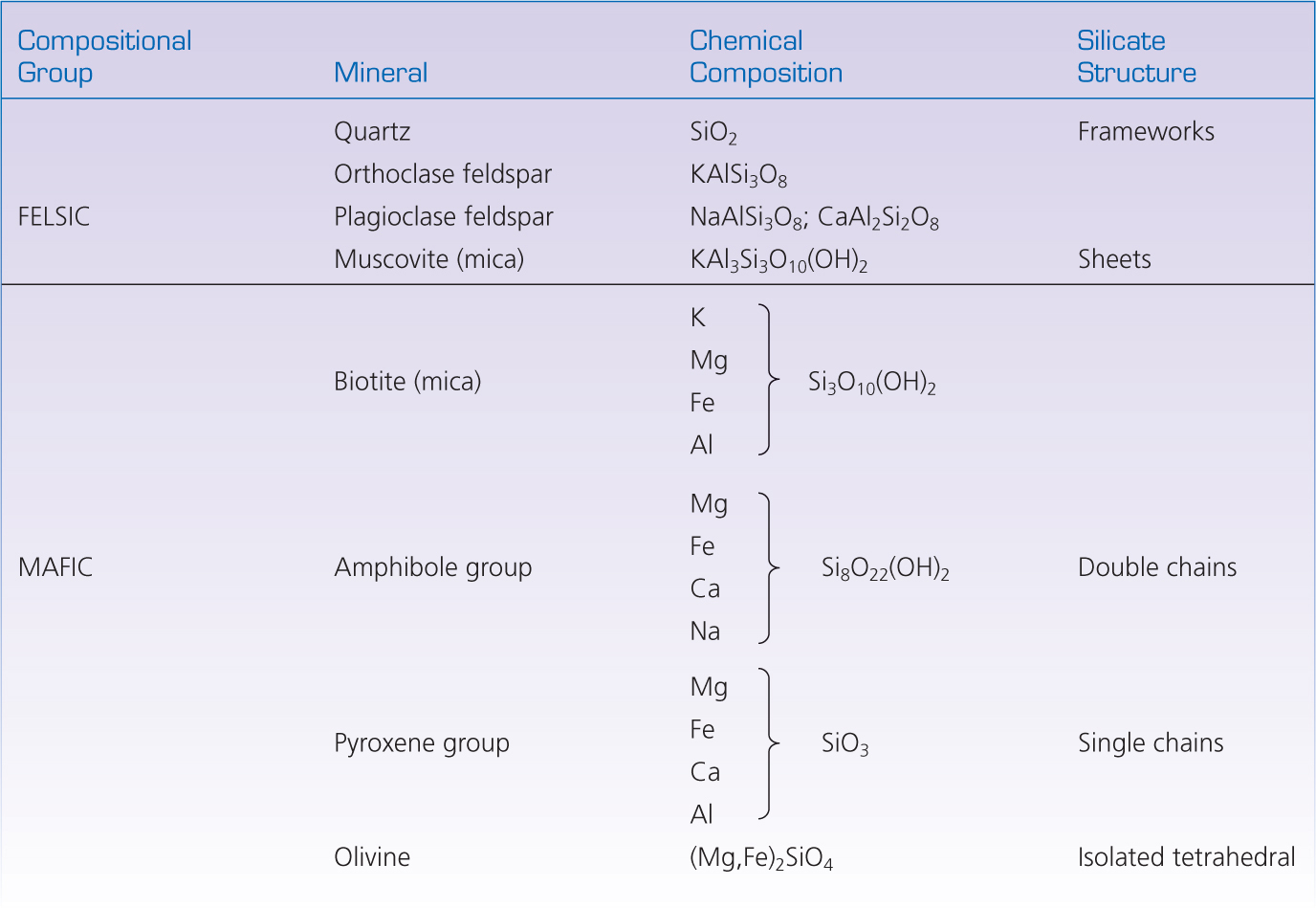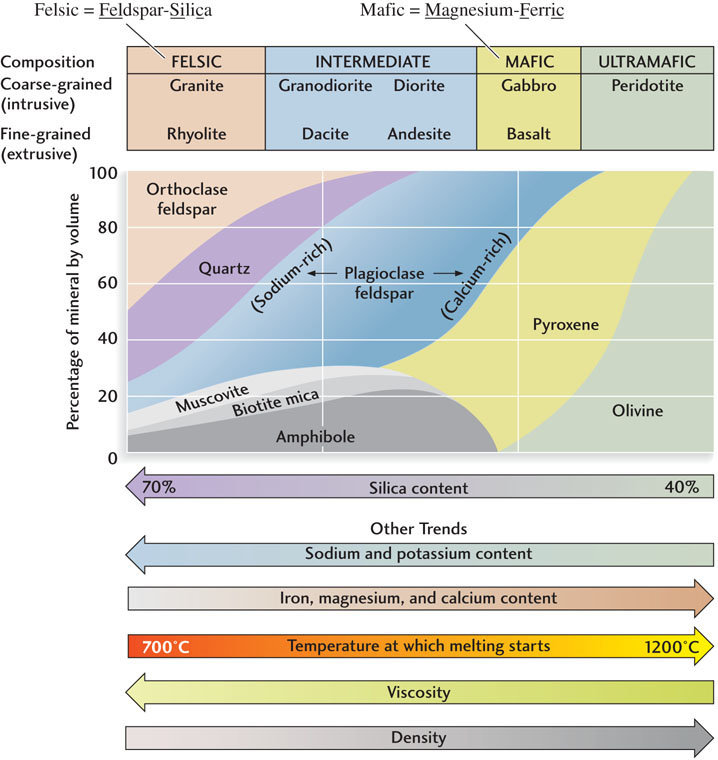How Do Igneous Rocks Differ from One Another?
Geologists today classify igneous rock samples in the same way some geologists did in the late nineteenth century: by their texture and by their mineral and chemical composition.
Texture
Two hundred years ago, the first division of igneous rocks was made on the basis of texture, which largely reflects differences in mineral grain size: geologists classified rocks as either coarse-grained or fine-grained (see Chapter 3). Grain size is a simple characteristic that geologists can easily see in the field. A coarse-grained rock, such as granite, has distinct crystals that are easily visible to the naked eye. In contrast, the crystals of a fine-grained rock, such as basalt, are too small to be seen, even with a magnifying glass. Figure 4.1 shows samples of granite and basalt, accompanied by photomicrographs of very thin, transparent slices of each rock. Photomicrographs, which are simply photographs taken through a microscope, give us an enlarged view of minerals and their textures. Textural differences were clear to early geologists, but several more clues were needed to unravel the meaning of those differences.

First Clue: Volcanic Rocks
Early geologists observed volcanic rocks forming from lava during volcanic eruptions. (Lava is the term that we apply to magma flowing out onto Earth’s surface.) They noted that where lava cooled rapidly, it formed either a fine-grained rock or a glassy one in which no crystals could be distinguished. Where lava cooled more slowly, as in the middle of a thick flow many meters high, somewhat larger crystals were formed.
Second Clue: Laboratory Studies of Crystallization
Just over a hundred years ago, experimental scientists began to understand the nature of crystallization. Anyone who has frozen a tray of ice cubes knows that water solidifies to ice in a few hours as its temperature drops below the freezing point. If you have ever attempted to retrieve your ice cubes before they were completely solid, you may have seen thin ice crystals forming at the surface and along the sides of the tray. During crystallization, the water molecules take up fixed positions in the solidifying crystal structure, and they are no longer able to move freely, as they did when the water was liquid. All other liquids, including magmas, crystallize in this way.
The first tiny crystals form a pattern. Other atoms or ions in the crystallizing liquid then attach themselves in such a way that the tiny crystals grow larger. It takes some time for the atoms or ions to “find” their correct places on a growing crystal, so crystals grow large only if they have time to grow slowly. If a liquid solidifies very quickly, as a magma does when it erupts onto the cool surface of Earth, the crystals have no time to grow. Instead, a large number of tiny crystals form simultaneously as the liquid cools and solidifies.
Third Clue: Granite as Evidence of Slow Cooling
By studying volcanoes, early geologists determined that fine-grained textures indicate quick cooling at Earth’s surface and that fine-grained igneous rocks are evidence of former volcanism. But in the absence of direct observation, how could geologists deduce that coarse-grained rocks form by slow cooling deep in Earth’s interior? Granite—one of the commonest rocks of the continents—turned out to be the crucial clue (Figure 4.2). James Hutton, one of geology’s founding fathers, saw granite cutting across and disrupting layers of sedimentary rock as he worked in the field in Scotland. He noticed that the granite had somehow fractured and invaded the sedimentary rock, as though the granite had been forced into the fractures as a liquid.

93
As Hutton looked at more and more granites, he began to focus on the sedimentary rocks bordering them. He observed that the minerals of the sedimentary rocks in contact with the granite were different from those found in sedimentary rocks at some distance from the granite. He concluded that the changes in the sedimentary rocks must have resulted from great heat, and that the heat must have come from the granite. Hutton also noted that the granite was composed of interlocked crystals (see Figure 4.1). By this time, chemists had established that a slow crystallization process produces this pattern.
With these three lines of evidence, Hutton proposed that granite forms from hot molten material that solidifies deep within Earth. The evidence was conclusive because no other explanation could accommodate all the facts. Other geologists, who saw the same characteristics of granites in widely separated places throughout the world, came to recognize that granite and many similar coarse-grained rocks were the products of magma that had crystallized slowly in Earth’s interior.
Intrusive and Extrusive Textures
The full significance of an igneous rock’s texture is now clear: it is linked to the rate, and therefore the place, of cooling. An intrusive igneous rock is one that has forced its way into the surrounding rock, called country rock, and solidified without reaching Earth’s surface. Slow cooling of magma in Earth’s interior allows adequate time for the growth of the large, interlocking crystals that characterize intrusive igneous rocks (Figure 4.3).

Rapid cooling at Earth’s surface produces the fine-grained texture or glassy appearance of extrusive igneous rocks (see Figure 4.3). These rocks, formed partly or largely of volcanic glass, are formed from material that erupts from volcanoes. For this reason, they are also known as volcanic rocks. They fall into two major categories based on the type of erupted material from which they are formed:
 Lavas: Volcanic rocks formed from flowing lavas range in appearance from smooth and ropy to sharp, spiky, and jagged, depending on the conditions under which they are formed.
Lavas: Volcanic rocks formed from flowing lavas range in appearance from smooth and ropy to sharp, spiky, and jagged, depending on the conditions under which they are formed. Pyroclasts: In more violent eruptions, pyroclasts form when fragments of lava are thrown high into the air. Volcanic ash is made up of extremely small fragments, usually of glass, that form when escaping gases force a fine spray of magma from a volcano. Bombs are larger particles hurled from the volcano and streamlined by the air as they hurtle through it. As they fall to the ground and cool, these fragments of volcanic debris may stick together to form rocks.
Pyroclasts: In more violent eruptions, pyroclasts form when fragments of lava are thrown high into the air. Volcanic ash is made up of extremely small fragments, usually of glass, that form when escaping gases force a fine spray of magma from a volcano. Bombs are larger particles hurled from the volcano and streamlined by the air as they hurtle through it. As they fall to the ground and cool, these fragments of volcanic debris may stick together to form rocks.
94
One volcanic rock type is pumice, a frothy mass of volcanic glass in which a great number of spaces remain after trapped gas has escaped from the solidifying melt. Another wholly glassy volcanic rock type is obsidian; unlike pumice, it contains only tiny vesicles and so is solid and dense. Chipped or fragmented obsidian produces very sharp edges, and Native Americans and many other hunting groups used it for arrowheads and a variety of cutting tools.
A porphyry is an igneous rock that has a mixed texture in which large crystals “float” in a predominantly fine-grained matrix (see Figure 4.3). The large crystals, called phenocrysts, form in magma while it is still below Earth’s surface. Then, before other crystals can grow, a volcanic eruption brings the magma to the surface, where it cools quickly to a finely crystalline mass. In some cases, porphyries form as intrusive igneous rocks; for example, they may form where magmas cool quickly at very shallow levels in the crust. Porphyry textures are important to geologists because they show that different minerals crystallize at different rates, a point that will be emphasized later in this chapter.
In Chapter 12, we will look more closely at how volcanic processes form extrusive igneous rocks. Now, however, we turn to the second way in which the family of igneous rocks is subdivided.
Chemical and Mineral Composition
We have just seen how igneous rocks can be subdivided according to their texture. They can also be classified on the basis of their chemical and mineral composition. Volcanic glass, which is formless even under a microscope, is often classified by chemical analysis alone. One of the earliest classifications of igneous rocks was based on a simple chemical analysis of their silica content. Silica (SiO2) is abundant in most igneous rocks, accounting for 40 to 70 percent of their total weight.
Modern classifications group igneous rocks according to their relative proportions of silicate minerals (Table 4.1; see also Appendix 4).
The silicate minerals—quartz, feldspars, muscovite and biotite micas, amphiboles and pyroxenes, and olivine—form a systematic series. Felsic minerals are the highest in silica; mafic minerals are the lowest in silica. The adjectives felsic (from feldspar and silica) and mafic (from magnesium and ferric, from the Latin ferrum, “iron”) are applied both to minerals and to rocks containing large proportions of those minerals. Mafic minerals crystallize at higher temperatures—that is, earlier in the cooling of a magma—than felsic minerals.

95
As the mineral and chemical compositions of igneous rocks became known, geologists soon noticed that some extrusive and intrusive rocks were identical in composition and differed only in texture. Basalt, for example, is an extrusive rock formed from lava. Gabbro has exactly the same mineral and chemical composition as basalt, but forms deep in Earth’s crust (see Figure 4.3). Similarly, rhyolite and granite are identical in composition, but differ in texture. Thus, extrusive and intrusive rocks form two chemically and mineralogically parallel sets of igneous rocks. Conversely, most of the chemical and mineral compositions in the felsic-to-mafic series we have just described can appear in either extrusive or intrusive rocks. The only exceptions are very highly mafic rocks, which rarely appear as extrusive igneous rocks.
Figure 4.4 is a model that portrays these relationships. The horizontal axis plots silica content as a percentage of a given rock’s weight. The percentages given—from high silica content at 70 percent to low silica content at 40 percent—cover the range found in igneous rocks. The vertical axis plots mineral content as a percentage of a given rock’s volume. This model can be used to classify an unknown rock sample with a known silica content: by finding its silica content on the horizontal axis, you can determine its mineral composition and, from that, the type of rock it is.

We can use Figure 4.4 to guide our discussion of intrusive and extrusive igneous rocks. We begin with the felsic rocks at the far left of the model.
Felsic Rocks
Felsic rocks are poor in iron and magnesium and rich in felsic minerals that are high in silica. Such minerals include quartz, orthoclase feldspar, and plagioclase feldspar. Orthoclase feldspars, which contain potassium, are more abundant than plagioclase feldspars. Plagioclase feldspars contain varying amounts of calcium and sodium; as Figure 4.4 indicates, they are richer in sodium near the felsic end and richer in calcium near the mafic end of the scale. Thus, just as mafic minerals crystallize at higher temperatures than felsic minerals, calcium-rich plagioclases crystallize at higher temperatures than sodium-rich plagioclases.
Felsic rocks tend to be light in color. Granite, one of the most abundant intrusive igneous rocks, contains about 70 percent silica. Its mineral composition includes abundant quartz and orthoclase feldspar and a smaller amount of plagioclase feldspar (see the far left of Figure 4.4). These light-colored felsic minerals give granite its pink or gray color. Granite also contains small amounts of muscovite and biotite micas and amphibole. Rhyolite is the extrusive equivalent of granite. This light brown to gray rock has the same felsic composition and light coloration as granite, but it is much more fine-grained. Many rhyolites are formed largely or entirely of volcanic glass.
96
Intermediate Igneous Rocks
Midway between the felsic and mafic ends of the scale are the intermediate igneous rocks. As their name indicates, these rocks are neither as rich in silica as the felsic rocks nor as poor in it as the mafic rocks. We find the intermediate intrusive igneous rocks to the right of granite in Figure 4.4. The first is granodiorite, a light-colored rock that looks something like granite. It is also similar to granite in having abundant quartz, but its predominant feldspar is plagioclase, not orthoclase. To its right is diorite, which contains still less silica and is dominated by plagioclase feldspar, with little or no quartz. Diorites contain a moderate amount of the mafic minerals biotite, amphibole, and pyroxene. They tend to be darker than granite or granodiorite.
The volcanic equivalent of granodiorite is dacite. To its right in the extrusive series is andesite, the volcanic equivalent of diorite. Andesite derives its name from the Andes, the volcanic mountain belt in South America.
Mafic Rocks
Mafic rocks contain large proportions of pyroxenes and olivines. These minerals are relatively poor in silica but are rich in magnesium and iron, from which they get their characteristic dark colors. Gabbro is a coarse-grained, dark gray intrusive igneous rock. Gabbro has an abundance of mafic minerals, especially pyroxenes. It contains no quartz and only moderate amounts of calcium-rich plagioclase feldspar.
Basalt is the most abundant igneous rock of the crust, and it underlies virtually the entire seafloor. This dark gray to black rock is the fine-grained extrusive equivalent of gabbro. In some places, extensive thick sheets of basalt, called flood basalts, form large plateaus. The Columbia River basalts of Washington State and the remarkable formation known as the Giant’s Causeway in Northern Ireland are two examples. The Deccan flood basalts of India and the Siberian flood basalts of northern Russia were formed by enormous outpourings of basalt that appear to coincide closely with two of the greatest periods of mass extinction in the fossil record.
97
Ultramafic Rocks
Ultramafic rocks consist primarily of mafic minerals and contain less than 10 percent feldspar. Here, at the far right of Figure 4.4, with a silica content of only about 45 percent, we find peridotite, a coarse-grained, dark greenish gray rock made up primarily of olivine with smaller amounts of pyroxene. Peridotites are the dominant rocks in Earth’s mantle, and as we will see, they are the source of the basaltic magmas that form rocks at mid-ocean ridges. Ultramafic rocks are rarely found as extrusives. Because they solidify at such high temperatures, they are rarely liquid and hence do not form typical lavas.
Trends in the Felsic-To-Mafic Series
The names and exact compositions of the various rocks in the felsic-to-mafic series are less important to remember than the trends shown in Figure 4.4. There is a strong correlation between a rock’s mineralogy and its temperature of crystallization or melting. As Table 4.2 indicates, mafic minerals melt at higher temperatures than felsic minerals. At temperatures below their melting point, minerals crystallize; therefore, mafic minerals also crystallize at higher temperatures than felsic minerals. We can also see that silica content increases as we move from the mafic end to the felsic end of the series. Increasing silica content results in increasingly complex silicate structures (see Table 4.1), which interfere with a melted rock’s ability to flow. Thus, viscosity—the measure of a liquid’s resistance to flow—increases as silica content increases. Viscosity is an important factor in the behavior of lavas, as we will see in Chapter 12. Increasing silica content also results in decreasing density, as we saw in Chapter 1.

It is clear that an igneous rock’s mineralogy provides a great deal of information about the conditions under which the rock’s parent magma formed and crystallized. To interpret this information accurately, however, we must understand more about igneous processes. We turn to that topic next.